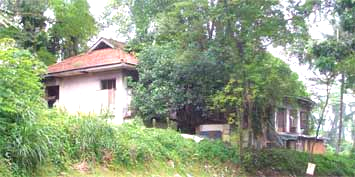NEW STRAITS TIMES 2009/02/18
INVASION OF MALAYA:
Sexual Slavery in wartime KL
 |
| One of the buildings in present-day Kuala Lumpur which housed comfort women during the Japanese Occupation. |
JUGUN IANFU is not a term many people are familiar with. It is Japanese for "military comfort woman", whose existence has been repeatedly and vehemently denied.
The jugun ianfu were created because the Japanese Imperial Army believed that offering the so-called "comfort women" to its soldiers would prevent them from committing random sexual violence against women of the "occupied territories".
These comfort women existed in all the occupied territories, including Malaya and Singapore.
Chye Kooi Loong, a historian from Kampar, Perak, recounted that there were several brothels in Kampar operated by locals and the Japanese. He said the Japanese "house of disrepute" was more popular as it charged less for its services.
"It was actually the 'soft approach' of the brutal Kempetai (Japanese secret police) to solicit secrets from patrons and it was subsidised by Tokyo."
There were many Japanese comfort women houses around Kuala Lumpur as well. One was in a row of double-storey pre-war bungalows with a courtyard in Jalan Tun Razak, close to the National Library and Bernama headquarters.
After the war, government officers were housed in these buildings. Later, they were occupied in turn by the Limkokwing College of Art and Sal College. They are now abandoned.
This establishment and another which was located in what is now a large dilapidated bungalow, on a low ridge over Jalan Hose not far from the Chinese Assembly Hall, was reserved for Japanese officers.
There was also a cluster of three two-storey bungalows opposite today's City Square in Jalan Tun Razak which housed comfort women for lower ranking Japanese soldiers. It was used by Indah Water Konsortium for a few years and later demolished.
Tai Sun Hotel, which was located on the corner of Jalan Pudu and Jalan Imbi diagonally opposite the Pudu Jail, was another of these establishments.
In Singapore, there were many cases of Japanese prison guards visiting medical officers amongst their prisoners of war for treatment for venereal diseases.
"Of course, we had no drugs suitable for the treatment of such diseases but the Japanese dared not report their condition to their own medics, as this was a serious offence," wrote Paul Gibs Pancheri, a PoW in Changi, in his book Volunteer which was released at the end of the war.
He said the medical officer would give the Japanese "patient" a list and would tell the guard to take the list to a chemist and only if he brought back all the items would he be cured.
"By this means, the Japanese got his cure and we got all kinds of essential drugs that our captors would not release to us," said Pancheri.
Among the most essential items they obtained this way were sulfa drugs, malaria medicine, ointments for skin troubles and the "priceless" May & Baker M&B 639, an antiseptic medicine for skin conditions.
Tragic tale of a Malayan comfort woman |
The cover of a book by George Hicks (left) which says that the Imperial Japanese Army kept over 100,000 comfort women during World War 2, and George C.C. Yong (right) who says Madam X sought compensation from the Japanese Government because she needed money for medical treatment. SHE was just 15 when a Japanese collaborator led Japanese soldiers in two trucks into her village in February 1942. That night, she was brutally raped on the kitchen floor of her home by several of the soldiers.
|
